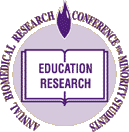We’re once again soliciting applications from research-intensive institutions for the NIGMS Institutional Research and Academic Career Development Award program.
Now in its 12th year, the IRACDA program supports traditional postdocs at research-intensive universities who also teach at nearby institutions with substantial enrollments of minority students. The program offers an opportunity to conduct top-notch research while developing teaching and other academic skills, such as problem-solving, communication, time management and grant-writing. Eighteen institutions currently participate in the program.
Because the IRACDA program combines a traditional mentored research experience with instruction, it prepares scientists for careers in both research and teaching. It also benefits the students at the institutions where the teaching takes place. So far, the data indicate that IRACDA postdocs do as well as or better than their peers in publishing and in getting jobs in academia and industry.
In fostering a diverse scientific workforce, IRACDA is a model program. Underrepresented groups currently make up about 28.5% of the national population, yet just 9.1% of college-educated Americans in science and engineering occupations. Nationally, about 7.5% of postdocs are from underrepresented groups. The IRACDA program, although not targeted to minorities, has about 40% of its postdocs from underrepresented groups. The program also strengthens the overall teaching and research opportunities at institutions with substantial minority enrollments. In these ways, IRACDA further promotes the development of the next generation of a diverse pool of scientists who are available to address the Nation’s biomedical, behavioral and clinical research needs.
IRACDA also addresses the growing recognition that future faculty should not only be able to conduct research, but also be effective teachers in the classrooms. Most faculty positions require some amount of teaching, and so it’s only natural that postdocs are trained in modern pedagogy before they start teaching as part of their faculty duties. To this end, major research universities are beginning to offer teaching certificate programs for their doctoral students.
If you’d like to know more about IRACDA or find out how you can participate, please contact me.



